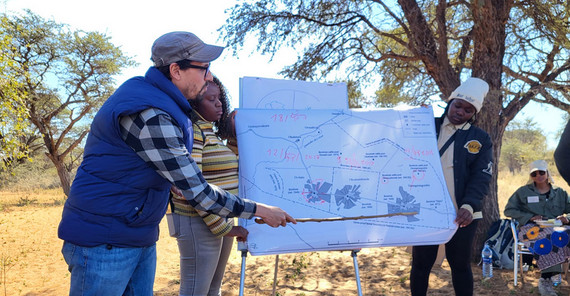To kick off the day, representatives from the three universities and the headmen of the three participating villages offer their welcome. They all express their optimism that through collaboration and mutual learning the challenges faced by communal farmers can be overcome.
Prof. Anja Linstädter (University of Potsdam) then provides a brief introduction to the NamTip project, outlining its goals and introducing the concept of ecological tipping points. Next, Dr. Clara Nesongano (UNAM) presents indicators that can be used by farmers to determine the condition of their rangeland. In her highly interactive talk, she presents grass samples that can serve as proxies for rangeland conditions, sparking great interest among the gathered farmers. She compares the rangeland to a sick person, saying that just as rest and medicine gradually heal someone, changes to rangeland might not be immediately visible, but over time they can lead to restoration.
Following, Dr. Mark Bilton addresses the issue of bush encroachment. He emphasizes the importance of bush thinning for maintaining healthy rangeland condition. He uses plant samples to illustrate the changes in grass species caused by ongoing bush encroachment. His presentation is complemented by many insightful questions and additions from the audience.
Dr. Diego Menestrey Schwieber then presents a map developed in close collaboration with local communal farmers, showing the entire communal area, comprising all three villages. He addresses the issue of too many cattle in a small area, leading to degradation, especially near the camps and the water holes. He stresses that, in its current state, the land can sustainably support only one head of cattle per 18 hectares-a limit that is being exceeded in all of the villages.
After a short lunch break, we listen to presentations by learners of the EduVentures, under the guidance of Corris Kaapehi. It is truly impressive to see young people presenting their findings-not only well-prepared and confident, but also adhering to a clear scientific structure, including introduction, methods, results, and discussion. These presentations are highlighting the success of the project’s component focusing on school learners, each of whom expressed a desire to continue their studies after school. They are the future scientists of Namibia.
Following NUST PhD candidate Nali Moyo introduces strategies to restore degraded rangelands. She outlines different methods, including resting and reseeding, linking each one to specific experiments carried out within the NamTip project. Her competent presentation sparks great interest in the farmers’ audience, with many comments and shared experiences.
Dr. Diego Menestrey Schwieber then presents additional strategies developed with local farmers. One central proposal is the construction of a fence along the main road and surrounding the entire communal area. This would prevent people from having to keep animals close to their homes, allowing for smaller camps and, consequently, an increase in the size of the communal grazing area, which would therefore have to sustain a smaller number of livestock per hectare. He also emphasizes the importance of implementing rotational grazing, using more fences to divide the area into four distinct grazing zones.
The day concludes with a lively discussion and some final words of thanks from a member of the Okakarara conservancy, before we travel back, very tired but also very satisfied from a highly successful day.
Link to NamTip website: https://www.uni-potsdam.de/en/namtip



